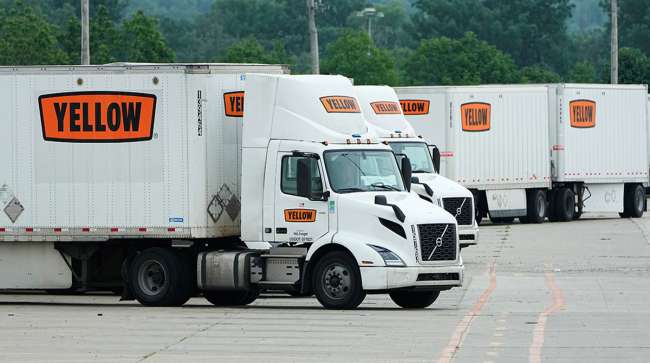Staff Reporter
Used Truck Market Can Likely Handle Yellow Liquidation

[Stay on top of transportation news: Get TTNews in your inbox.]
Used trucks and trailers owned by bankrupt Yellow Corp. are set to come up for auction in unprecedented numbers, but the market can handle it, say observers.
A liquidation of this size has not been seen for decades, Stacy Tracy, president of auctioneers Taylor & Martin Inc., told Transport Topics, adding that it was by far the biggest sale by value in the history of the trucking industry.
Still, said Tracy, “the market has the appetite to consume this type of volume.”
Part of that is because of the methodical approach from the administrators of the less-than-truckload company’s liquidation, said Steve Tam, ACT Research vice president, who leads the research and forecasting group’s used truck practice.

Tracy
“If [the administrators] were to dump all of that on the market tomorrow it would be a challenge for the industry to deal with,” Tam said, but “they are striving very ardently to maximize the proceeds. [The administrators are] going at it with a steady approach and not looking to flood the market.”
Also, the freight industry has undergone equipment shortages in recent years, and the Yellow trucks and trailers coming onto the market are not going to fill all the holes, said DAT Analytics Chief of Analytics Ken Adamo.
Yellow ranks No. 13 on the Transport Topics Top 100 list of the largest for-hire carriers in North America.
Yellow owned around 12,700 tractors and 42,000 trailers at the end of the second quarter of 2023, according to company documents.
In April 2022, Yellow said it had replaced nearly a third of its older over-the-road longhaul trucking fleet, which it called the “backbone” of its delivery operations. Yellow bought 1,400 new Volvo VNR tractors in 2021 and 2022.
A year earlier, Yellow inked what Paccar Inc. said was the single-largest order of Peterbilt trucks with a Paccar powertrain, buying 1,222 Model 579s.
Yellow paid for the fresh rolling stock with $400 million of the controversial $700 million loan from the U.S. Department of the Treasury. Intended to shore up Department of Defense supply chain problems during the COVID-19 pandemic, the funds could only be used for pension, health and welfare payments for union employees and modernizing the company’s rolling stock.
The infusion of newer model vehicles is beneficial to the sale, but like many an LTL fleet, there is still a sizable percentage of much older trucks in the fleet, observers say.
“There’s a barbell of younger trucks in [Yellow’s] fleet and also a barbell of much older trucks in the fleet,” said ACT’s Tam.

Payne
Yellow is understood to still have as many as 3,000 model year 2022 and 2023 trucks, which are likely to be gobbled up pretty quickly, said Kriete Truck Centers Director of Used Truck Sales Kelly Payne.
That newer rolling stock could possibly be sold on a retail level, Tam said, while older trucks and trailers are likely to be sold at auction or in the wholesale market.
Most of the trucks are day cabs, which works in the favor of the bankruptcy administrators, Tam said. Day cab demand is still fairly strong, added Payne.
There is ample supply of sleeper cabs at the moment, Tam said, adding that there is not a tremendous amount of day cab equipment sitting around.
However, there are a lot more trailers for sale at the moment, whereas during the pandemic they were very hard to find, Payne said.
Day cabs are not just popular in the LTL sector that Yellow inhabited, said Taylor & Martin’s Tracy. The agriculture sector uses a lot more day cabs than sleepers, he said. There are a lot of trucking segments that will be interested in the stock outside of the LTL sector, said Tracy.
Had Yellow filed for Chapter 11 protection from the courts 12 months ago, the return on selling off the rolling stock would have been much greater, observers say.

Transport Topics' Seth Clevenger, Michael Freeze and Mike Senatore dissect the new Top 100 list of the largest private carriers, including how fleets are adapting to this softened market. Tune in above or by going to RoadSigns.ttnews.com.
Values for Class 8 trucks are down 30% to 35% compared with 12 months ago, Tam said, if an aggregate is taken across all makes, models and ages.
The average used truck retail sale price was $68,316 in June, down 26.4% from $92,778 a year earlier, and 1.1% lower on a month-on-month basis from May’s $69,052 in May, according to the latest ACT Research data.
Truck prices had to come back to reality, but usually in a freight down cycle they go even lower, said Eric Starks, chairman of economic forecasting group FTR. July saw a fifth straight year-over-year decline in monthly truck tonnage, according to American Trucking Associations data.
The average sale price of a Class 8 truck is around $50,000, said Tam, with retail market values a great deal higher than those at auction or wholesale. The average wholesale price is between $40,000 and $45,000, while the average auction price is between $25,000 and $35,000, he said.
Used day cab prices, however, are down about 6% to 7% compared with the end of 2022 for trucks of the same age and mileage, versus about 30% for all models, Payne said.
New England Motor Freight was the last large liquidation of this type in 2019, said Tracy, but was nowhere near the magnitude of the Yellow auction. NEMF’s liquidation involved 1,093 trucks and 3,855 trailers, grossing $46.6 million, according to Tracy.
Before that, said Tracy, the last liquidations with a similar impact were in the 20th century: McLean Trucking Co. and AmeriTruck Distribution Corp.
Want more news? Listen to today's daily briefing above or go here for more info
Day cab market prices will drop as a result of the dispersal of Yellow’s fleet, Payne said. “Any time there’s going to be this amount of stock flooding the market it is a huge deal,” he said.
However, the saturation of the market will be lower if the sales are spread out more broadly, Tracy said.
“The prices will be determined by how the equipment is liquidated. If you just sell it to the top five to 10 LTLs the prices will be lower; it is important to offer it on a greater scale and to the many diverse sectors and segmentations that the trucking industry comprises,” he said.




